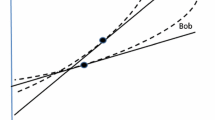Abstract
Andreoni and Levinson’s (J Public Econ 80:269–286, 2001) EKC model is modified to include Stone (Econ J 63:511–527, 1954) and Geary (Rev Econ Stud 18(99):65–66, 1950) preferences where the economic agent has a minimum consumption requirement (MCR). We show that at each level of income, an increase in the MCR is associated with higher levels of pollution, and the threshold level of income at which the EKC inverts changes with a change in the MCR. A numerical exercise further supports these findings. We offer a policy discussion within the context of the environmental impacts of meeting a MCR noting that doing so is costly in terms of the impact on pollution and the resources required to mitigate pollution in its presence.

Similar content being viewed by others
Notes
See Jeffords and Shah (2013) for more on the connection between minimum consumption requirements and economic and social rights, in particular, the human right to water as set within a classic nonrenewable resource model inclusive of a backstop technology.
In a previous iteration of this paper, we estimated a one-period lagged cross-sectional country-level EKC using purchasing-power-parity adjusted per capita consumption from the World Bank Global Consumption Database as a proxy for the minimum consumption requirement. Based on a sample of 89 countries and differentiating the consumption amounts by sector (e.g., rural vs. urban), the results supported the theoretical and numerical findings but with many caveats and data limitations. Nonetheless, these results and the corresponding discussion are available upon request.
References
Andreoni, J., Levinson, A.: The simple analytics of the environmental Kuznets curve. J. Public Econ. 80, 269–286 (2001)
Antweiler, W., Copeland, B.R., Taylor, M.S.: Is free trade good for the environment? Am. Econ. Rev. 91, 877–908 (2001)
Brock, W.A., Taylor, M.S.: The green solow model. J. Econ. Growth 15, 127–153 (2010)
Carson, R.T.: The environmental Kuznets curve: seeking empirical regularity and theoretical structure. Rev. Environ. Econ. Policy 4, 3–23 (2009)
Egli, H., Steger, T.: A simple dynamic model of the environmental Kuznets curve: turning point and public policy. Environ. Resour. Econ. 36(15), 34 (2007)
Geary, R.: A note on a constant-utility index of the cost of living. Rev. Econ. Stud. 18(99), 65–66 (1950)
Grossman, G.M., Krueger, A.B.: Environmental impacts of a North American free trade agreement. National Bureau of Economic Research Working Paper 3914, NBER, Cambridge, MA (1991)
International Covenant on Economic, Social, and Cultural Rights. http://www.ohchr.org/EN/ProfessionalInterest/Pages/CESCR.aspx (1966). Accessed 1 Mar 2018
Jeffords, C., Shah, F.: On the natural and economic difficulties to fulfilling the human right to water within a neoclassical economics framework. Rev. Soc. Econ. 71, 65–92 (2013)
John, A., Pecchenino, R.: An overlapping generations model of growth and the environment. Econ. J. 104, 1393–1410 (1994)
Lieb, C.M.: The environmental Kuznets curve and flow versus stock pollution: the neglect of future damages. Environ. Resour. Econ. 29, 483–506 (2004)
Lopez, R.: The environment as a factor of production: the effects of economic growth and trade liberalization. J. Environ. Econ. Manag. 27, 163–184 (1994)
Pfaff, A., Chaudhury, S., Nye, H.: Household production and environmental kuznets curves: examining the desirability and feasibility of substitution. Environ. Resour. Econ. 27(2), 187–200 (2004)
Selden, T.M., Song, D.: Neoclassical growth, the J curve for abatement, and the inverted U curve for pollution. J. Environ. Econ. Manag. 29, 162–168 (1995)
Stern, D.I.: The rise and fall of the environmental Kuznets curve. World Dev. 32, 1419–1439 (2004)
Stokey, N.L.: Are there limits to growth? Int. Econ. Rev. 39, 1–31 (1998)
Stone, R.: Linear expenditure systems and demand analysis: an application to the pattern of British demand. Econ. J. 63, 511–527 (1954)
Thompson, A.: Specifying the EKC: downstream dependence in water pollution. Theoret. Econ. Lett. 4, 743–747 (2014)
Author information
Authors and Affiliations
Corresponding author
Additional information
Publisher’s Note
Springer Nature remains neutral with regard to jurisdictional claims in published maps and institutional affiliations.
Rights and permissions
About this article
Cite this article
Jeffords, C., Thompson, A. The human rights foundations of an EKC with a minimum consumption requirement: theory, implications, and quantitative findings. Lett Spat Resour Sci 12, 41–49 (2019). https://doi.org/10.1007/s12076-019-00225-1
Received:
Accepted:
Published:
Issue Date:
DOI: https://doi.org/10.1007/s12076-019-00225-1



